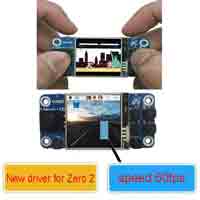- sales/support
Google Chat: zj734465502@gmail.com
- sales
+86-0755-88291180
- sales01
sales@spotpear.com
- sales02
dragon_manager@163.com
- support
tech-support@spotpear.com
- CEO-Complaints
zhoujie@spotpear.com
- sales/support
WhatsApp:13246739196
- HOME
- >
- ARTICLES
- >
- Raspberry Pi
- >
- Raspberry Pi LCD
- >
- GPIO-SPI
Raspberry Pi 1.54inch LCD Bookworm-Desktop Display and Touch
Step 1】Test Environment
Official image version:2024-03-12-raspios-bookworm-armhf.im
Pi' Version : 4B、5B
HAT : spotpear rpi-1.54inch-lcd
Step 2】Configure SPI display:
Copy spotpear_240x320_st7789.dtbo to /boot/overlays/ directory】
sudo cp spotpear_240x240_st7789_lcd1inch54.dtbo /boot/overlays/
Edit config.txt configuration file】
sudo nano /boot/firmware/config.txt
Disable KMS】
#dtoverlay=vc4-kms-v3d
#max_framebuffers=2
Add the following configuration at the end of the file】
dtparam=spi=on
dtoverlay=spotpear_240x240_st7789_lcd1inch54
hdmi_force_hotplug=1
max_usb_current=1
hdmi_group=2
hdmi_mode=87
hdmi_cvt 480 480 60 6 0 0 0
hdmi_drive=2
display_rotate=0
Download, compile and install fbcp】
sudo apt update
sudo apt-get install git -y
sudo git clone https://github.com/tasanakorn/rpi-fbcp.git
cd ./rpi-fbcp/
sudo mkdir -m 777 ./build
cd ./build/
sudo apt install libraspberrypi-dev -y
sudo apt-get install cmake -y
sudo cmake ..
sudo make
sudo install fbcp /usr/local/bin/fbcp
Set auto-start startx and fbcp】
sudo nano ~/.bash_profile
Note: If there is no .bash_profile file, create one yourself
Add the following code to the bottom of the .bash_profile file】
if [ "$(cat /proc/device-tree/model | cut -d ' ' -f 3)" = "5" ]; then
# Raspberry Pi 5B configuration
export FRAMEBUFFER=/dev/fb1
startx 2> /tmp/xorg_errors
else
# Non-Raspberry Pi 5B configuration
export FRAMEBUFFER=/dev/fb0
sleep 20
fbcp &
startx 2> /tmp/xorg_errors
fi
Set CLI automatic login】
sudo raspi-config nonint do_boot_behaviour B2
Noto: This command has optional parameters
B1 - Boot to console, requiring login
B2 - Boot to console, logging in automatically
B3 - Boot to desktop, requiring login
B4 - Boot to desktop, logging in automatically
Note: Make sure the username of the Raspberry Pi is pi, otherwise it will not log in automatically
Switch to X11】
sudo raspi-config nonint do_wayland W1
Note: This command has optional parameters
W1 - Use the X11 backend
W2 - Use the Wayland backend
The above configuration will take effect after restart】
sudo reboot
Note: After setting all the above configurations, the system will become longer during each restart, and SSH also needs to wait for a while to enter;
Step 3】Configure Touch:
Install the calibrator software
sudo apt-get install xserver-xorg-input-evdev
sudo cp -rf /usr/share/X11/xorg.conf.d/10-evdev.conf /usr/share/X11/xorg.conf.d/45-evdev.conf
sudo apt-get install xinput-calibrator
Edit the 99-calibration.conf configuration file】
sudo nano /usr/share/X11/xorg.conf.d/99-calibration.conf
Section "InputClass"
Identifier "calibration"
MatchProduct "ADS7846 Touchscreen"
Option "Calibration" "326 3536 3509 256"
Option "SwapAxes" "1"
Option "EmulateThirdButton" "1"
Option "EmulateThirdButtonTimeout" "1000"
Option "EmulateThirdButtonMoveThreshold" "300"
EndSection
The above configuration will take effect after restart】
sudo reboot




